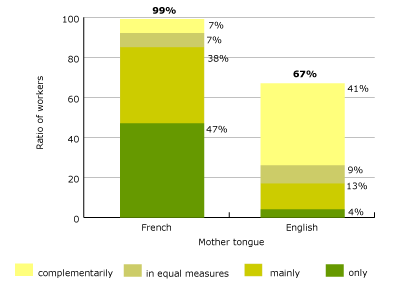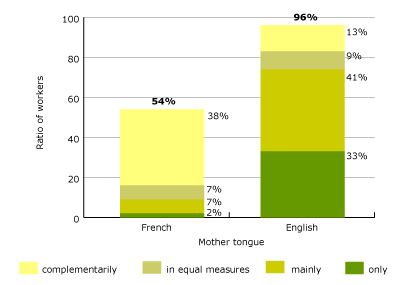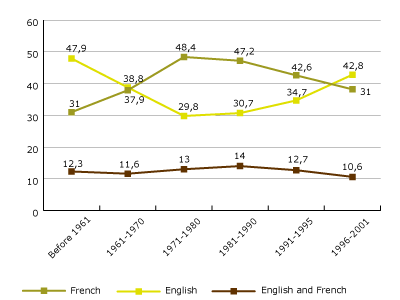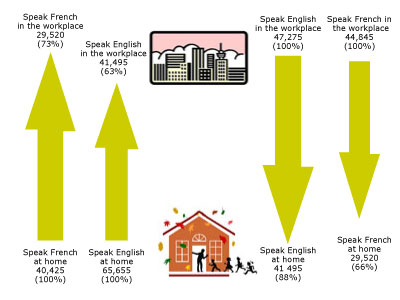
Multilingualism in the workplace, within the context of the francisation of businesses in Quebec , by Virginie Moffet and Pierre Bouchard |
||||
| CONTINUA |
3.1 The situation in Quebec and in the metropolitan Montreal area This data shows that 82 % of workers usually work in French in Quebec (Quebec Office for the French language, 2006: indicator 2.9). In addition, by means of the second section dedicated to the matter, it is also possible to establish whether the workers targeted are using other languages in the workplace. In order to accurately assess this issue, we have drawn up the following typology for the two sections of matter of the language in the workplace. Typology of the use of French ad English in the workplace
It shows for example that although 59 % of these workers use French exclusively, the remaining 41% use English to varying degrees of frequency when not exclusively. (Quebec Office of the French language, 2006: indicator 2.13). Having clarified those issues, we will now focus on the Montreal metropolitan area, which comprises both the island of Montreal and its peripheral regions (the “crown” of Montreal). Half of all employment in Quebec is indeed concentrated within this are, which also happens to be the most diverse in terms of languages: almost 30% of workers are not of French mother tongue, while this proportion does not exceed 6% in other areas of Quebec. This area has other interesting features derived from its linguistic disparity (the island of Montreal compared with the crown of Montréal) and the commuting which characterises it: 40 % of those residing in peripheral areas work on the island. In the metropolitan area of Montreal as a whole, 72 % of those who work tend to do so in French: 42 % only use this language and 30 % work predominantly in French, while resorting to English to a minor extent. Still, the situation observed on the territories of the island of Montréal is very different: 88 % of manpower works mainly in French in the crown area of Montreal, compared with 65% within the island (9). On the island of Montreal we can accurately say that the near totality (99 %) of native French speaking workers uses their mother language at work: 47 % use French, 38 % use mainly French, and 14 % use it to the same extent or less than English. With regard o their English speaking colleagues, two thirds of them (67 %) speak French at work, 4 % only use French, 13 % use it over English, 9 %, to the same extent as English and 41 %, use it less frequently than English. In parallel, English is also frequently used by the workforce based on the island of Montreal: 54 % of French speaking workers use it, (38 % in a complementary manner) and this proportion amounts to 96 % with English speaking workers (33 % use only this language). Graphique 1
Graphique 2
3.2 Workers of tertiary mother tongue and immigrants The sustained use of French and the non-negligible use of English are equally perceivable with workers who do not have French or English as a mother language. Indeed, the percentage of workers who use French (78 %) is similar to that of those who use English (77 %). As shown in the following table, this equality is perceivable for each frequency of use for each working language. Table 1. Ratio of workers of tertiary mother language according to the frequency of usage of French and English in the workplace
It is important to state the extent to which the time the immigrants came to live in Quebec has affected things as it puts an altogether different perspective on the situation: with regard to those who arrived before 1961, English is the predominant language in the workplace, as back in those days, over half of the Montreal working population used to work in that language. With regard to immigrants from subsequent slices, that is, those who immigrated from 1961 to 1970, French and English are used in similar ratios (»38 %) whereas in later ones, that is, 1971 to 1980 and 1981 to 1990, French is used by half of the workforce whilst English is the working language in about 30% of all cases. With more recently arrived immigrants, it has been noted that a smaller ratio of workers appear to use French compared to the previous two slices. Moreover, with regard to the workers who arrived between 1996 and 2001, the use of English is slightly more widespread than French in the workplace (43% vs. 38 %). These figures are summarized in the graph below. Graphique 3. Ratio of immigrant workers of tertiary mother tongue according to language used in the workplace. Island of Montréal, 2001
3.3 Languages spoken in the home vs. language spoken in the workplace The Canadian census allows us to see the link between then language most frequently used a home and the one used in the workplace. The data analysed shows that three quarters of workers of tertiary mother tongue who speak French at home tend to work in French, whereas of those who speak English at home, two thirds also speak it in the workplace. This indicates that it is more common for workers of tertiary mother language who have substituted their own language for French (10) to work in French as well than is the case when English is the substituted language. Figure 2
From the reverse perspective, that is, when observing the link between the use of a language at work and the consequent use of that same language in the home, we can conclude that in the case of workers of tertiary mother tongue who have carried out a linguistic replacement and most frequently use English in the workplace, 88 % also use English at home. This link between the language spoken at work and that used in the home is weaker on the French speaking front: 66 % of those who work in French also speak French at home. In conclusion, the link between the language used at work and that used in the home seems more pronounced when workers of tertiary mother tongue use English at work rather than French. |
|||||||||||||||||||||||||||||||||||||||||||||||||||||||||||||||||||||



